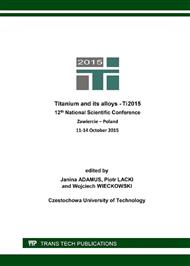p.87
p.92
p.98
p.106
p.111
p.117
p.125
p.133
p.141
The Methods of Surface Preparations of Titanium Alloys Applicable for Friction Pairs in Endoprostheses
Abstract:
The paper presents the results of tribological tests on titanium alloys subjected to modification of surface layer. The tests were conducted with metal biomaterials coated with TiN layer and anodized, applied in knee and hip joint endoprostheses. One of the ways of improving abrasion resistance of metal and polyethylene elements of endoprostheses is TiN coating by means of PVD method. It results in getting the metal of high bio-compatibility and more friction resistant. The research were carried out for various friction pairs applied in total knee and hip joint endoprostheses.
Info:
Periodical:
Pages:
111-116
Citation:
Online since:
April 2016
Authors:
Keywords:
Price:
Сopyright:
© 2016 Trans Tech Publications Ltd. All Rights Reserved
Share:
Citation:


